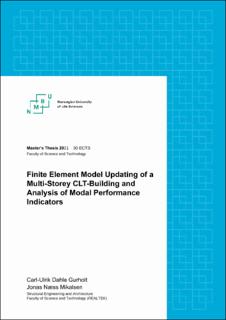| dc.contributor.advisor | Ussher, Ebenezer | |
| dc.contributor.advisor | Aloisio, Angelo | |
| dc.contributor.advisor | Tomasi, Roberto | |
| dc.contributor.author | Gurholt, Carl-Ulrik Dahle | |
| dc.contributor.author | Mikalsen, Jonas Næss | |
| dc.date.accessioned | 2021-10-14T13:37:36Z | |
| dc.date.available | 2021-10-14T13:37:36Z | |
| dc.date.issued | 2021 | |
| dc.identifier.uri | https://hdl.handle.net/11250/2823105 | |
| dc.description.abstract | The dynamic behaviour of multi-storey CLT-buildings due to operational excitation is an open issue; few in-situ test have been carried out to estimate their modal parameters. Moreover, there is a gap in knowledge about the use of ambient vibration measurements for model-updating purposes of timber buildings, and the performance indicators of timber buildings due to operational excitation is not yet thoroughly studied. In this thesis, the results of Operational Modal Analysis is interpreted and analysed in light of multiple Finite Element models in order to better understand the dynamic behaviour of CLT-buildings.
The analytical procedure is divided into three parts. A Finite Element model is constructed based on the geometry and estimates of parameter values of the Palisaden building. A large set of parameters is chosen for an optimization algorithm to minimize the difference between analytical and experimental modal data. The true parameter values are then extracted from a Finite Element Model Updating scheme based on sensitivity analysis. In the second part of analysis, the Finite Element model is adjusted to involve the numerical behaviour of connector elements to the optimization algorithms. The role of connector elements to the low-amplitude dynamics of the building is analysed and discussed based on sensitivity analysis. The third part of analysis consists of a parametric study to investigate the effects of eccentricity between center of mass and center of rigidity. A set of new Finite Element models are constructed to highlight the modal responses of changes in plan geometry of the building.
The initial Finite Element model do not correctly represent the modal behaviour of the building, with modal analysis providing fundamental frequencies about 30 % higher than the experimental values. Sensitivity analysis and model updating highlights the impact of all parameter values to the dynamic behaviour of the building, and an updated model is shown to have a high accuracy. Similar analysis on the connector elements prove that the connectors do in fact have very little impact on the low-amplitude dynamics of the building. In the third case, several interesting modal phenomena arise due to differences in eccentricity and plan shape geometry. | en_US |
| dc.language.iso | eng | en_US |
| dc.publisher | Norwegian University of Life Sciences, Ås | en_US |
| dc.rights | Attribution-NonCommercial-NoDerivatives 4.0 Internasjonal | * |
| dc.rights.uri | http://creativecommons.org/licenses/by-nc-nd/4.0/deed.no | * |
| dc.title | Finite element model updating of a multi-storey CLT-building and analysis of modal performance indicators | en_US |
| dc.type | Master thesis | en_US |
| dc.description.localcode | M.BA | en_US |

